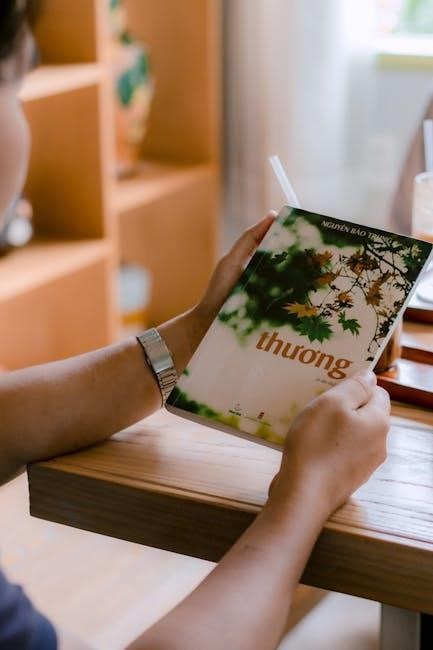
memoirs of a geisha pdf book
Memoirs of a Geisha by Arthur Golden is a captivating novel that explores the life of Sayuri, a young geisha in 1930s Japan. The book delves into the intricate world of geisha culture, revealing both its beauty and harsh realities. Published in 1997, it has become a timeless tale of resilience, love, and self-discovery, offering a unique glimpse into a fascinating and often misunderstood tradition.
Background and Setting
Memoirs of a Geisha is set in 1930s Japan, a time of cultural transition and societal change. The story unfolds in the traditional quarters of Kyoto, where geisha culture thrived. Sayuri, the protagonist, is born into poverty as a fisherman’s daughter but is sold to a geisha house, marking the beginning of her transformation. The novel vividly portrays the rigid hierarchy and intricate customs of the geisha world, where young girls undergo rigorous training in arts, music, and dance. The setting shifts from the serene beauty of traditional Japan to the turmoil of World War II, which disrupts Sayuri’s life and the geisha culture. This historical backdrop highlights the resilience and adaptability of geisha in the face of modernity and conflict.
Publication Details
Memoirs of a Geisha was first published in 1997 by Chatto & Windus in London. The novel, written by Arthur Golden, spans 434 pages in its original hardcover edition. It has since been widely distributed in paperback, e-book, and audiobook formats. The book is available for free download in PDF and EPUB formats on platforms like Internet Archive and z-lib.org. Its global popularity led to translations in multiple languages, further expanding its reach. The novel’s success has also made it accessible on various online platforms, ensuring its availability for readers worldwide. This accessibility has contributed to its enduring popularity, making it a staple in modern literary collections.
Author Background
Arthur Golden, born in 1957, is an American novelist and historian. He studied Japanese art and history at Harvard and Columbia, inspiring his meticulous research for Memoirs of a Geisha.
About Arthur Golden
Arthur Golden, born in 1957, is an American novelist and historian with a deep passion for Japanese culture. He earned degrees in art history from Harvard and Columbia universities, which heavily influenced his writing. Golden’s extensive research on geisha traditions and Japanese history laid the foundation for Memoirs of a Geisha, his debut novel. The book’s success showcased his ability to blend historical accuracy with compelling storytelling. Despite criticism from some in the geisha community, Golden’s work remains a significant contribution to understanding this enigmatic world. His meticulous research and cultural insights have made him a respected voice in historical fiction.
Research and Inspiration
Arthur Golden conducted extensive research to craft Memoirs of a Geisha, immersing himself in the world of geisha culture. He studied the arts, traditions, and history of geisha, ensuring authenticity. Golden interviewed a former geisha, which provided invaluable insights into the secretive and intricate lifestyle. His meticulous research spanned years, allowing him to capture the nuances of this enigmatic world. The novel reflects his deep understanding of the geisha’s dual role as both artist and courtesan. Golden’s dedication to accuracy and his ability to weave historical details into a compelling narrative have made the book a landmark in historical fiction, offering readers a vivid portrayal of 1930s Japan and the geisha tradition.
Plot Summary
Memoirs of a Geisha follows Sayuri, a young girl sold into geisha training, as she navigates a world of beauty, rivalry, and resilience in 1930s Japan.

Early Life of Sayuri
Sayuri, born as Chiyo Sakamoto, grows up in a small fishing village in 1930s Japan. She lives with her poor family, including her father, mother, and older sister, Satsu. After her mother’s death, Chiyo’s life takes a dramatic turn when she and her sister are sold to a geisha house in Kyoto. Chiyo is sent to the Nitta okiya, where she begins her journey to become a geisha. Despite her challenging circumstances, Chiyo’s striking beauty and natural talent set her apart, making her a promising candidate for the geisha tradition. Her early life is marked by resilience and determination, laying the foundation for her future as one of Japan’s most celebrated geisha.
Training as a Geisha
Sayuri’s training as a geisha is rigorous and transformative. She learns traditional arts such as music, dance, and poetry, as well as the subtleties of conversation and etiquette. Under the guidance of her mentor, Mameha, Sayuri masters the intricate customs of geisha culture, including the art of wearing kimonos and the proper way to apply makeup. Her training also involves navigating the complex social dynamics of the geisha world, where rivalry and politics play significant roles. Despite the challenges posed by her antagonist, Hatsumomo, Sayuri’s dedication and natural talent propel her toward becoming a renowned geisha. Her training not only shapes her skills but also molds her identity, preparing her for the demands of her profession.

Themes
Geisha Culture and Coming of Age are central themes, exploring the intricate world of geisha life, personal growth, and resilience. The novel highlights the contrast between beauty and hardship, delving into themes of identity, exploitation, and the enduring power of love and loss.

Geisha Culture
Geisha culture is a central theme in Memoirs of a Geisha, showcasing the intricate and often misunderstood world of Japan’s traditional entertainers. Geisha are highly skilled artisans, mastering music, dance, and conversation, rather than being merely courtesans. The novel highlights the rigorous training geisha undergo, emphasizing their role as performers and cultural preservationists. Sayuri’s journey reveals the duality of geisha life: the beauty of their artistry contrasts with the harsh realities of exploitation and societal expectations. The auctioning of a geisha’s virginity and the hierarchical structure of the geisha community are vividly portrayed, offering insight into the complexities of this centuries-old tradition. Golden’s depiction challenges Western stereotypes, presenting geisha as resilient women navigating a world of elegance and hardship.
Coming of Age
Sayuri’s journey in Memoirs of a Geisha is a poignant coming-of-age story, tracing her transformation from a young girl to a renowned geisha. Her early life, marked by poverty and loss, sets the stage for her resilience. The novel explores her struggles with identity, as she navigates the rigid expectations of geisha culture while holding onto her inner self. The auction of her virginity and her rise to fame symbolize her transition from innocence to adulthood. Through her experiences, Golden highlights the emotional and societal challenges of growing up in a world where tradition and personal desire often clash. Sayuri’s story is a powerful exploration of self-discovery, resilience, and the complexities of womanhood in a deeply patriarchal society.

Historical Context
Memoirs of a Geisha is set in 1930s-1940s Japan, a time of cultural transformation and wartime upheaval. The novel explores the decline of traditional geisha culture during this period, offering insights into Japan’s societal shifts and the impact of World War II on its people. The story reflects the tension between ancient traditions and modernization, providing a vivid backdrop for Sayuri’s journey. This historical setting enriches the narrative, highlighting the resilience of geisha and the changing dynamics of Japanese society during a tumultuous era.
Japan in the 1930s-1940s
During the 1930s-1940s, Japan underwent significant cultural and societal changes. The rise of militarism and the onset of World War II deeply impacted the nation, altering traditional practices. In this backdrop, Memoirs of a Geisha unfolds, depicting the life of Sayuri, a young girl from a humble fishing village who rises to fame as a geisha. The novel highlights the rigid social hierarchies and the decline of geisha culture as modernization and war disrupted traditional ways of life. Sayuri’s journey reflects the resilience of women in a rapidly changing world, while also revealing the harsh realities of a society in flux. The historical context of wartime Japan adds depth to the narrative, showcasing the tension between tradition and modernity. This period serves as a poignant setting for Sayuri’s story of survival and transformation.
Role of Geisha
In Memoirs of a Geisha, the role of a geisha is intricately portrayed as a blend of artistry and companionship. Geisha are highly skilled entertainers trained in music, dance, and conversation, serving as companions to wealthy patrons. Contrary to Western misconceptions, geisha are not prostitutes but rather artisans who master their crafts. Their role involves creating an illusion of intimacy and emotional connection, often masking their true feelings. In the novel, Sayuri’s journey highlights the duality of her role—performing as an artist while navigating the complex societal expectations placed upon her. The geisha’s position in Japanese culture is one of elegance and refinement, yet it also reveals the underlying struggles of women in a rigid, male-dominated society. This dual identity is central to the narrative, showcasing both the beauty and the burdens of the geisha’s world.

Availability
Memoirs of a Geisha is widely available in PDF format on platforms like Internet Archive and z-lib.org, offering free downloads for readers worldwide, ensuring easy access to this beloved novel.
PDF Versions Online
PDF versions of Memoirs of a Geisha are readily available online, offering readers convenient access to Arthur Golden’s iconic novel. Platforms like Internet Archive and z-lib.org provide free downloads, making it easy for fans to enjoy the book digitally. These PDFs are often complete and well-formatted, ensuring a seamless reading experience. Additionally, many websites offer flipbook versions, allowing readers to navigate the novel’s pages effortlessly. The availability of these digital formats has made the book more accessible than ever, catering to a global audience. Whether for academic purposes or personal enjoyment, the PDF versions of Memoirs of a Geisha remain a popular choice among readers worldwide.
Platforms Offering the Book
Several platforms offer Memoirs of a Geisha in various formats, catering to diverse reader preferences. Internet Archive provides free PDF and EPUB versions, while z-lib.org offers downloadable options. Flipbook versions are available on platforms like AnyFlip, allowing readers to navigate the novel’s pages digitally. Additionally, online libraries and eBook repositories host the book, ensuring global accessibility. These platforms make it easy for readers to access Arthur Golden’s masterpiece, whether for academic research or personal enjoyment. The widespread availability of Memoirs of a Geisha on these platforms highlights its enduring popularity and the demand for digital reading options in today’s fast-paced world.
Reception
Memoirs of a Geisha received widespread acclaim for its vivid storytelling and cultural depth, resonating with readers worldwide. Its emotional impact and historical richness left a lasting impression.
Critical Acclaim
Memoirs of a Geisha garnered widespread critical acclaim for its vivid storytelling and profound cultural insights. Reviewers praised Arthur Golden’s meticulous research and his ability to craft a compelling narrative that humanizes the geisha world. The novel’s emotional depth and rich characterization, particularly in its portrayal of Sayuri’s journey, resonated deeply with readers. Critics highlighted the book’s ability to balance historical context with personal drama, making it both informative and engaging. The novel’s success lies in its universal themes of resilience, identity, and the pursuit of one’s destiny, which transcended cultural boundaries. Its acclaim solidified its place as a modern literary classic, earning it a spot on bestseller lists worldwide.
Commercial Success
Memoirs of a Geisha achieved remarkable commercial success upon its release in 1997. It became a bestseller worldwide, topping the New York Times bestseller list for 58 weeks. The novel sold millions of copies globally, establishing Arthur Golden as a prominent author. Its popularity endured long after its initial release, with translations into over 30 languages. The book’s success was further amplified by its adaptation into a major film in 2005, introducing the story to an even broader audience. Its widespread appeal lies in its universal themes and vivid portrayal of a unique culture, making it a beloved and enduring literary phenomenon. The novel’s commercial success has cemented its place as a modern classic, continuing to captivate readers and inspire new adaptations and discussions.
Characters
The novel focuses on Sayuri, a young geisha, and her complex relationship with Hatsumomo, her tormentor. Other key characters include Mameha, Pumpkin, and the Chairman, each playing pivotal roles in her journey.
Sayuri: Protagonist
Sayuri, the protagonist of Memoirs of a Geisha, is a young girl from a poor fishing village in 1930s Japan. Sold into geisha training, she rises to become one of Kyoto’s most celebrated geisha. Her journey is marked by resilience, as she navigates the intricate and often cruel world of geisha culture. Sayuri’s story is one of transformation, from a naive child to a sophisticated artist, while enduring personal sacrifices and emotional turmoil. Her complex relationship with Hatsumomo, her rival, and her unspoken love for the Chairman drive the narrative. Through her experiences, Sayuri embodies both the elegance and the hardships of geisha life, making her a deeply relatable and inspiring character.

Hatsumomo: Antagonist
Hatsumomo is the ruthless antagonist in Memoirs of a Geisha, serving as a formidable obstacle in Sayuri’s journey. As a senior geisha, she wields immense power and manipulates those around her, particularly targeting Sayuri with cruelty and jealousy. Hatsumomo’s actions are driven by a deep-seated resentment, making her a complex and intimidating figure. Her relentless sabotage and emotional torment of Sayuri highlight the darker aspects of geisha culture. Despite her polished exterior, Hatsumomo’s true nature is revealed through her manipulative tactics and eventual downfall, showcasing the consequences of unchecked ambition and malice. Her role underscores the challenges Sayuri faces, adding depth to the narrative and emphasizing the harsh realities of her world.
Cultural Significance
Memoirs of a Geisha offers a profound portrayal of geisha culture, blending artistry with harsh realities. It sparked global interest in Japan’s traditions, revealing both beauty and struggle.
Portrayal of Geisha Life
Memoirs of a Geisha vividly portrays the intricate and often misunderstood world of geisha culture. The novel captures the rigorous training, artistic mastery, and emotional struggles of geisha life. Sayuri’s journey reveals the duality of her existence: a performer admired for her beauty and talent, yet bound by societal expectations and personal sacrifices. Golden’s depiction highlights the elegance of traditional arts, such as music and dance, alongside the harsh realities of competition, rivalry, and the commodification of a geisha’s virtue. The book also explores the emotional depth of geisha, showcasing their resilience and the hidden pain behind their polished facade. This portrayal has sparked both admiration and controversy, making it a significant cultural commentary on Japan’s geisha tradition.
Cultural Accuracy
Memoirs of a Geisha has sparked debates about its cultural accuracy. While it captures the elegance of geisha traditions, such as music, dance, and poetry, some critics argue that it oversimplifies or misrepresents certain aspects of geisha life. For instance, the novel portrays geisha as both artists and courtesans, which aligns with historical truths, but its focus on the auctioning of virginity has been disputed as exaggerated. Additionally, the book’s portrayal of the geisha hierarchy and rivalries, while compelling, has been criticized for sensationalism. Despite these criticisms, the novel remains a significant work that has introduced many readers to the complexities of geisha culture, even if it does not fully align with the lived experiences of real geisha. Its cultural significance lies in its ability to provoke dialogue about representation and authenticity.

Educational Value

Memoirs of a Geisha offers profound insights into Japanese culture, history, and societal norms, making it a valuable resource for literature and cultural studies in educational settings.
Use in Literature
Memoirs of a Geisha is widely used in literature studies for its rich narrative and cultural depth. The novel serves as a primary source for exploring themes like identity, resilience, and cultural transformation. Its first-person perspective provides a unique lens for analyzing storytelling techniques and character development. Educators often incorporate it into curriculum to discuss historical fiction, cross-cultural narratives, and the portrayal of women in society. The book’s vivid depiction of geisha culture also makes it a valuable resource for understanding Japanese history and traditions. Its accessibility and engaging prose have made it a popular choice for book clubs and academic discussions, fostering deeper insights into themes of gender roles and societal expectations;
Insights into Culture
Memoirs of a Geisha offers profound insights into Japanese culture, particularly the intricate world of geisha. The novel vividly portrays the traditions, rituals, and societal norms of 1930s-1940s Japan, providing a window into a rarely seen lifestyle. It highlights the duality of the geisha world, where beauty and artistry coexist with exploitation and societal constraints. The book explores the role of women in a patriarchal society, shedding light on their resilience and resourcefulness. Golden’s detailed descriptions of tea ceremonies, kimono attire, and musical performances bring cultural nuances to life; The novel also examines the tension between tradition and modernity, offering readers a deeper understanding of Japan’s rich heritage and the challenges faced by its people during a transformative era.

Comparisons
Memoirs of a Geisha is often compared to its film adaptation, with the book providing deeper, more nuanced character development and richer cultural insights for a more immersive experience.
Film Adaptation
The film adaptation of Memoirs of a Geisha, directed by Rob Marshall and released in 2005, brought the novel to life with stunning visuals and a star-studded cast, including Zhang Ziyi as Sayuri. While the movie captured the essence of the book, it faced criticism for casting non-Japanese actors in key roles and deviations from the original story. Despite this, the film was praised for its cinematography and faithful portrayal of geisha culture. It grossed over $160 million worldwide, introducing the story to a broader audience; However, purists of the novel noted that the film lacked the depth and complexity of Golden’s writing, particularly in its handling of Sayuri’s internal struggles and the nuances of her relationships.
Book vs. Film
The book and film adaptation of Memoirs of a Geisha offer distinct experiences. The novel, written by Arthur Golden, provides a deeply personal and introspective account of Sayuri’s life, rich in emotional depth and cultural detail. In contrast, the 2005 film, directed by Rob Marshall, focuses more on visual storytelling, capturing the stunning aesthetics of geisha culture but simplifying the narrative. While the film succeeds in conveying the beauty and tragedy of Sayuri’s journey, it omits several key subplots and nuances from the book, such as the complexity of her relationships and the societal pressures she faces. Fans of the novel often prefer the book for its layered storytelling, while the film appeals to those drawn to its cinematic grandeur and performances.
Memoirs of a Geisha by Arthur Golden is a haunting novel about Sayuri’s journey as a geisha in 1930s Japan, exploring resilience and cultural beauty, leaving a timeless tale.
Memoirs of a Geisha by Arthur Golden is a novel published in 1997, recounting the life of Sayuri, a young girl from a poor fishing village in 1930s Japan. Sold to a geisha house in Kyoto, Sayuri endures a rigorous journey from servitude to becoming one of Japan’s most celebrated geisha. The story explores her struggles with rivalry, emotional turmoil, and the complexities of her profession. Despite her success, Sayuri remains haunted by her past and the loss of her first love. The novel vividly portrays the intricate world of geisha culture, blending beauty and hardship, and offers a poignant tale of resilience and self-discovery.
Final Thoughts
Memoirs of a Geisha is a deeply moving and thought-provoking novel that offers a unique perspective on Japan’s geisha culture. Arthur Golden’s meticulous research and vivid storytelling bring Sayuri’s journey to life, blending emotional depth with cultural insight. The novel challenges Western perceptions of geisha, highlighting their role as artists rather than mere entertainers. Sayuri’s resilience and determination resonate powerfully, making her story unforgettable. The book’s exploration of love, loss, and identity remains timeless, while its portrayal of 1930s-1940s Japan provides a rich historical context. For readers seeking a compelling and culturally enriching experience, Memoirs of a Geisha is an essential read, now widely available in PDF and other formats for global audiences to enjoy.